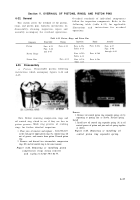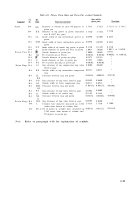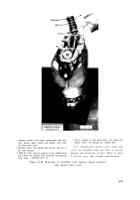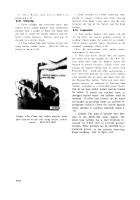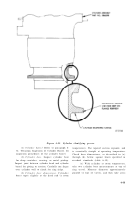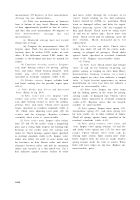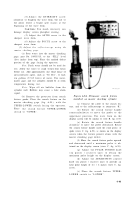TM-9-2815-200-35
ENGINE, WITH CONTAINER:TURBOSUPERCHARGED, DIESEL ,FUEL INJECTION ,90-DEGREE “V” TYPE, AIR - COOLED ,12 - CYLINDER , ASSEMBLY ;MODELS AVDS-1790-2M (2815-856-4996), AVDS-1790-2A AND AVDS-1790-2AM (2815-856-9005)
TECHNICAL MANUAL; DIRECT SUPPORT, GENERAL SUPPORT AND DEPOT MAINTENANCE MANUAL INCLUDING REPAIR PARTS AND SPECIAL TOOLS LISTS
TM-9-2815-200-35 - Page 350 of 779
measurement (90 degrees) to first measurement.
Average the two measurements.
(b) Take two measurements of diameter
bore at bottom of ring travel. Measure diameter
of bore approximately parallel to line of valves,
and then take cross measurement (90 degrees) to
firs t
measurement .
Averag e
th e
tw o
measurements.
(c) Head-end average must not exceed
flange-end average.
(d) Compare the measurements taken 90
degrees apart. Each two measurements (top or
bottom) must be within 0.003 inches of each
other. If the difference exceed 0.003 inches, the
cylinder is out-of-round and must be marked for
repair.
(4)
Camshaft bearing surface.
Inspec t
cam shaft bearing surface for pitting, galling,
burs, and nicks. Check bearing diameter, with
rocker
ar m
cover installed, against limit s
specified in overhaul standards (table 6-15).
(5)
Cylinder exterior.
Inspect cylinder head
and barrel cooling fins for possible repair (para
6-33 f).
d. Valve Rocker Arm Covers and Associated
Parts.
(Refer to fig. B-4)
(1)
Valve rocker arm cover.
Inspect valve
rocker arm cover (39) for cracks .
Inspect
cam shaft bearing surface in cover for galling,
pitting, burs, and nicks. Check cover against
limits specified in overhaul standards (table 6-
15). Check valve adjusting cover plate (29) for
cracks and for warpage .
Replace cylinde r
assembly when cover is unserviceable.
(2)
Valve rocker arms.
Inspect valve rocker
arms (33 and 34) for cracks, using a magnifying
glass and a strong light. Inspect the bushing-type
bearings in the rocker arms for scoring and
secure fit. Check bearings against limits specified
in overhaul standards (table 6-15). Inspect valve
rocker arm rollers for scuff or score marks and
for looseness on hub. Rotate roller and check
clearance between roller and hub by mounting
rocker arm securely in a soft-jawed vise. Set a
dial indicator against contact surface of roller
and move roller through the extremes of its
travel. Check reading on the dial indicator.
Limits should be 0.006L in. maximum. Mark
worn or damaged rollers and hubs for repair.
Inspect adjusting screws (36) for stripped or
dam aged threads. Check screw by turing screw
in and out of rocker arms. Screw must turn
freely. Check swivel pad on adjusting screw for
free
rotation,
Mark damaged parts fo r
replacement.
(3)
Valve rocker arm shafts.
Check valv e
rocker arm shafts (22 and 35) for cracks, nicks,
scoring, or plugged oil passages. Check shafts
against limits specified in overhaul standards
(table 6-15). Replace unserviceable shafts.
(4) Valves.
(a)
Valve head.
Check intake and exhaust
valve (11 and 12) for evidence of pitting, im-
perfect seating, or warping on valve head. Heavy
discoloration, burning, erosion, or a heav y
carbon deposit on valve face indicates a warped
valve.
A light frosted appearance or mino r
discoloration on valve face does not indicate a
warped or unserviceable valve.
(b)
Value stem.
Inspect the valve stems
and the locking groove in the stems for pitting,
scoring cracks, or damaged tips. Checks valves
against limits specified in overhaul standards
(table 6-15). Replace valves that are warped,
cracked, or unserviceable.
(5)
Valve
springs. Inspect inner spring (18),
intermediate spring (17), and outer spring (16)
for wear, cracks, set, or other evidence of failure.
Check all springs against limits specified in the
overhaul standards (table 6-15).
(6)
Valve spring retainers, valve rotors, and
locks.
Inspect valve spring retainers (19 and 38)
and intake valve spring seat (15) for wear and
cracks. Check exhaust valve roto r
(40) b y
rotating inner section. Inner section must rotate
freely. Inspect rotor for wear or cracks. Inspect
spring retainer locks for wear or cracks. Worn
locks will have ridges on top face. Replace any
unserviceable parts.
6-56
Back to Top


